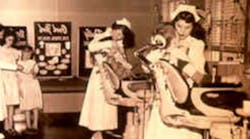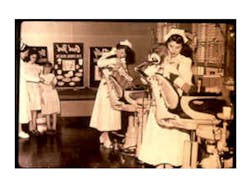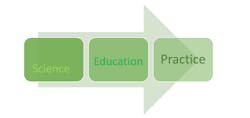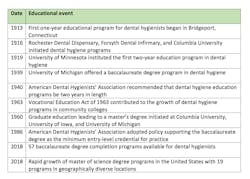The 100-year evolution of the science and practice of dental hygiene
Dental hygiene is still a relatively young health profession, just over 100 years old. The original vision of dental hygiene focused on its integration into existing infrastructure with the hope that dental hygienists could improve oral health and overall health by increasing the value society places on oral health.
Historical perspective
The founder of dental hygiene, Dr. Alfred C. Fones, educated the first dental hygienist, Irene Newman, for one year before she began treating patients in his practice. Fones was a true believer in preventive medicine and the value of quality nutrition, realizing the negative impact of processed and refined substitutes.1 He believed that preventive dental health care and education would improve the quality of life (figure 1).Dr. Fones envisioned dental hygienists working collaboratively with other health and social service workers in providing preventive health care to the public. He stated, “Dental hygiene . . . opens up paths of usefulness, activity, and inspiration hitherto undreamed of, allying her with the workers of the world who are helping humanity in masses.”2
Figure 1: Dental hygienists in schools, early 1900s
Courtesy of the Fones School of Dental Hygiene, University of Bridgeport, Bridgeport, CT
There are three areas that are specifically associated with the growth and evolution of dental hygiene (figure 2). These areas include the science, which is needed to provide education on evidenced-based knowledge; the education, which is needed to ensure an educated and qualified workforce; and both of these areas ultimately affect the quality of practice that is delivered to society.
Figure 2: Three areas of growth
Advancements in science
The origins of dental hygiene were grounded in scientific evidence. Dr. Alfred C. Fones conducted research to assess the effectiveness of dental hygienists from day one of providing care in schools.4 Data showed a 34% reduction of dental caries in permanent teeth of fifth graders after dental hygiene had been implemented when they began first grade.4 In 1926, an article published in the Journal of the American Dental Hygienists’Association presented information on research that documented the effectiveness of dental hygiene.5
Routine conduction of research by dental hygienists did not commence until the 1960s. The logical reason for this was the introduction of graduate education in dental hygiene. Now, dental hygiene periodicals are abundant with the fruits of dental hygiene research. This research is critical to education and practice, so that procedures and therapies are safe, effective, and have the ability to prevent disease and promote health. In essence, science is the backbone of dental hygiene.
Educational growth
Dental hygiene has grown significantly since the beginning of the 1900s, with education starting out as a one-year program (figure 3), which Fones early on advocated changing to two years.3 The current standard is a minimum of two academic years, although the majority of dental hygienists have four or more years of education (figure 4).4 In actuality, dental hygiene education has increased over the years, even though accreditation standards do not reflect this reality.
Figure 3: Historical timeline of educational advancements
Source: Darby ML, Walsh MM. Dental Hygiene Theory and Practice. 2nd edition. Philadelphia: Saunders, 2003.
Figure 4: Projected years of education upon program completion: data from 2016 first-year RDH students highest level of education, ADA Allied Health Survey 2016-2017
The American Dental Hygienists’ Association has advocated for an entry-level baccalaureate degree since 1986, and although most dental hygienists are not awarded this degree, most seem to have the number of credit hours necessary to attain this degree. Interestingly, advanced educational programs, including baccalaureate degree completion and master’s degree programs, have increased over the years (figure 5). Education is another area that continues to grow with the profession, so that dental hygienists continue to advance in overall educational levels.
Figure 5: Number of graduate programs in dental hygiene
Practice gains
The gains in dental hygiene practice are particularly exciting. The practice of dental hygiene has changed much in the first 100 years, with the introduction of ultrasonic inserts, a multitude of instruments designed for specific areas of the dentition, various types of fluoride, dental sealants, electronic health records, digital radiography, and periodontal assessment tools that include the use of periodontal probes.
Another area of growth is increased opportunities for individuals to access care directly from dental hygienists. Although dental hygiene initially started in settings outside of dental offices in Connecticut, most states positioned the dental hygienist within private dental offices. This was not necessarily bad for dental hygiene, since dentistry has been the biggest promoter of the preventive profession by employing the majority of dental hygienists over the years. However, dental hygiene can grow even more with an emphasis on employing dental hygienists outside of dental practices. This would help increase direct access to dental hygienists for individuals who do not regularly obtain dental care in private or corporate offices. This would increase the opportunity to provide preventive dental care and bring more individuals into private and corporate offices for the completion of comprehensive dental care. Subsequently, this will continue to provide more employment opportunities for the dental hygienist.
For maps outlining the current state of direct access legislation by state, please visit https://www.adha.org/sites/default/files/7524_Current_Direct_Access_Map_0.pdf.
Conclusion
Dental hygienists have come a long way within a small time frame, and they have changed the way Americans feel about prevention. Dental hygienists have had a significant role in the prevention movement witnessed in society today. Through the advancement of science and the increased educational attainment by dental hygienists, society will continue to see improved care provided by dental hygienists. The ultimate goal is always to provide the best care possible, and dental hygienists are constantly making this happen.
References
1. Fones AC. Mouth Hygiene, 3rd edition. Philadelphia: Lea & Febiger, 1925.
2. Fones AC. Mouth Hygiene, 2nd edition. Philadelphia: Lea & Febiger, 1916.
3. Motley WE. History of the American Dental Hygienists’ Association 1923-1982. Chicago: American Dental Hygienists’ Association, 1983.
4. Fones AC. Report of Five Years of Mouth Hygiene in the Public Schools of Bridgeport, Connecticut. Documents Division. Library of Congress: Washington DC, April 18, 1921.
5. Booker PD. Oral hygiene as an exact science. J Dent Hyg. 1926;11(2):14-22.
6. Allied Dental Education Survey Dental Hygiene. ADA website. http://www.ada.org/en/science-research/health-policy-institute/data-center/dental-education. Accessed June 11, 2018.
Christine Nathe, RDH, MS, is director at the University of New Mexico division of dental hygiene, in Albuquerque, New Mexico. She is also the author of Dental Public Health Research, which is in its fourth edition with Pearson. She can be reached at [email protected] or (505) 272-8147.
About the Author
Christine Nathe, MS, RDH
Christine Nathe, RDH, MS, is director at the University of New Mexico division of dental hygiene, in Albuquerque, New Mexico. She is also the author of Dental Public Health Research, which is in its fourth edition with Pearson. She can be reached at [email protected] or (505) 272-8147.





